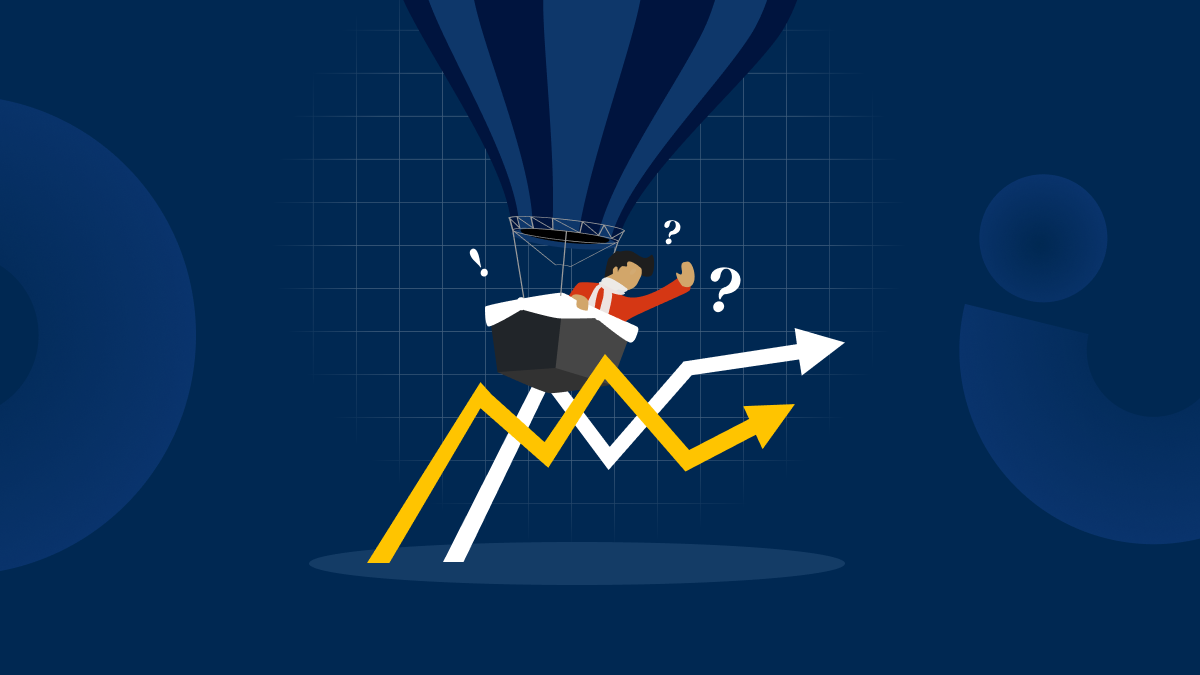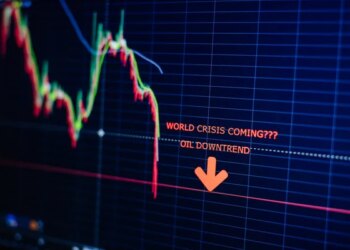What is Market Volatility?

Volatility is essentially a measure of how much an asset’s price fluctuates over a given period. It’s often associated with downturns, but markets can also be highly volatile during periods of rapid growth.
- A. What Causes Market Volatility?
- A. Economic Data and Reports: Unexpected economic news can trigger significant market reactions. This includes inflation reports, employment figures, GDP growth, consumer confidence indices, and manufacturing data. Positive or negative surprises can lead to rapid adjustments in asset prices as investors reassess future earnings potential or economic health.
- B. Geopolitical Events: Wars, political instability, trade disputes, or significant policy changes by governments can create widespread uncertainty and fear, leading to sharp market declines. Events like the Russian invasion of Ukraine or major electoral shifts can have global market repercussions.
- C. Corporate Earnings and News: Individual company announcements, such as quarterly earnings reports that miss or beat expectations, major product launches, management changes, or scandal revelations, can cause the stock price of that specific company, and sometimes its sector, to swing wildly.
- D. Interest Rate Changes and Central Bank Actions: Decisions by central banks (like the Federal Reserve in the US or the European Central Bank) regarding interest rates, quantitative easing, or tightening can profoundly impact market sentiment. Higher interest rates typically make borrowing more expensive, slowing economic growth and potentially reducing corporate profits, often leading to market pullbacks.
- E. Technological Advancements and Disruptions: Rapid technological change can create new industries and disrupt old ones. While innovations often drive long-term growth, the short-term impact on specific companies or sectors can be volatile as investors try to determine winners and losers. Think of the dot-com bubble or the rise of AI.
- F. Natural Disasters and Pandemics: Events like hurricanes, earthquakes, or widespread disease outbreaks (e.g., COVID-19) can cause significant economic disruption, supply chain issues, and shifts in consumer behavior, leading to widespread market volatility.
- G. Speculation and Investor Sentiment: Sometimes, market movements are driven by pure speculation, rumors, or a collective shift in investor psychology (fear or greed) rather than fundamental economic data. This can lead to market bubbles or crashes. Social media can exacerbate these trends.
- B. Types of Volatility:
- A. Historical Volatility: Measures past price fluctuations over a specific period. It tells you how much an asset’s price has moved in the past but doesn’t predict future movement.
- B. Implied Volatility: Derived from the pricing of options contracts, it represents the market’s expectation of future volatility. The VIX (CBOE Volatility Index) is a widely watched measure of implied volatility for the S&P 500 index, often called the “fear gauge.” A higher VIX generally indicates greater market uncertainty.
The Psychological Traps of Volatility
Our innate human psychology often works against us during volatile periods. Recognizing these biases is the first step to overcoming them.
- A. Fear and Panic Selling:
- The Trap: When markets drop sharply, the natural instinct is to sell everything to stop the “bleeding.” This is often the worst decision, as you lock in losses and miss the inevitable recovery.
- The Reality: Historically, market downturns are temporary. Selling out of fear means you’re buying high and selling low, which is the opposite of successful investing.
- B. Herding Behavior:
- The Trap: Following the crowd, whether it’s rushing into a hot stock at its peak or joining a mass sell-off.
- The Reality: The crowd is often wrong. Smart money often acts contrarian, buying when others are fearful and selling when others are greedy.
- C. Loss Aversion:
- The Trap: The psychological tendency to feel the pain of a loss more acutely than the pleasure of an equivalent gain. This can lead investors to hold onto losing investments too long hoping for a recovery or sell winning investments too early to “take profits.”
- The Reality: Rational decision-making requires objective analysis of an investment’s fundamentals, not just its current paper loss or gain.
- D. Confirmation Bias:
- The Trap: Seeking out and interpreting information that confirms your existing beliefs, while ignoring evidence that contradicts them. This can lead to tunnel vision and poor decisions based on incomplete data.
- The Reality: Actively seek out diverse perspectives and challenge your own assumptions.
- E. Recency Bias:
- The Trap: Giving more weight to recent events than to long-term historical trends. For example, believing the market will continue to fall because it has fallen recently.
- The Reality: Markets are cyclical. Historical data shows long-term growth despite numerous short-term corrections and bear markets.
Fundamental Strategies for Navigating Volatility

Successfully weathering market storms requires adherence to time-tested investment principles.
A. Long-Term Perspective
- A. Patience is a Virtue: Investing is a marathon, not a sprint. Focus on your long-term financial goals (retirement, buying a home, etc.) rather than short-term market fluctuations.
- B. Historical Resilience: The stock market has historically recovered from every downturn, eventually reaching new highs. Understanding this pattern helps mitigate panic during corrections.
- C. Compounding Power: The longer your money is invested, the more powerful compounding becomes. Short-term volatility becomes noise when viewed over decades.
B. Diversification
- A. Across Asset Classes: Don’t put all your eggs in one basket. Allocate your investments across different asset classes like stocks (equities), bonds (fixed income), and potentially real estate. When one asset class performs poorly, another might perform well, balancing your overall portfolio.
- B. Within Asset Classes:
- 1. Stocks: Diversify across different industries (tech, healthcare, consumer staples), company sizes (large-cap, mid-cap, small-cap), and geographies (domestic, international, emerging markets).
- 2. Bonds: Diversify by issuer (government, corporate), credit quality, and maturity dates.
- C. The Benefits: Diversification reduces portfolio risk without necessarily sacrificing returns. It smooths out returns over time and provides resilience during sector-specific downturns.
C. Dollar-Cost Averaging (DCA)
- A. Consistent Contributions: Investing a fixed amount of money at regular intervals (e.g., monthly or bi-weekly), regardless of the asset’s price.
- B. Automatic “Buy Low”: When prices are high, your fixed dollar amount buys fewer shares. When prices are low (during volatility), it buys more shares. Over time, this averages out your purchase price and reduces the risk of making a large investment at a market peak.
- C. Reduces Emotional Decisions: DCA removes the temptation to time the market, which is notoriously difficult even for professionals. It automates consistent investing.
D. Rebalancing Your Portfolio
- A. Maintaining Target Allocation: Periodically adjusting your portfolio back to your desired asset allocation (e.g., 70% stocks, 30% bonds).
- B. Selling High, Buying Low (Implicitly): If stocks have performed exceptionally well, your stock allocation might exceed your target. Rebalancing means selling some stocks (selling high) and buying more bonds (potentially buying low, or at least maintaining your desired risk profile). The opposite happens during a stock market downturn.
- C. Scheduled Reviews: Rebalance annually or semi-annually, or when an asset class deviates significantly from its target percentage (e.g., by 5% or more). This provides a disciplined approach to managing risk.
E. Focusing on Quality Investments
- A. Strong Fundamentals: During volatile periods, focus on companies with strong balance sheets, consistent earnings, manageable debt, and a competitive advantage (moat). These companies tend to be more resilient.
- B. Dividend Stocks: Companies that consistently pay dividends can provide income even during market downturns, and stable dividends often indicate financial health.
- C. Index Funds and ETFs: For most investors, low-cost broad-market index funds (e.g., S&P 500 index funds) or diversified ETFs are excellent choices. They provide instant diversification and track the market’s overall performance, which has historically been positive over the long term.
Actionable Steps During Market Downturns
While the core strategies are long-term, specific actions can be taken when volatility strikes.
A. Review, Don’t React
- A. Check Your Financial Plan: Revisit your original financial goals and your investment policy statement. Does the downturn fundamentally change your goals or timeline? For most long-term investors, the answer is no.
- B. Assess Your Risk Tolerance: If the volatility causes extreme anxiety, your initial risk assessment might have been too high. Consider a minor adjustment to a more conservative allocation during calmer times, but avoid making drastic changes during a panic.
B. Look for Opportunities
- A. “On Sale” Investments: A market downturn means quality assets are available at lower prices. For long-term investors, this can be an excellent opportunity to buy more shares at a discount.
- B. Tax-Loss Harvesting: If you have investments with significant losses in a taxable brokerage account, you can sell them to realize a loss, which can offset capital gains and a limited amount of ordinary income (up to $3,000 per year in the US). You can then reinvest the proceeds into a different, but similar, asset.
- C. Rebalance Opportunistically: As discussed, a downturn can be a prime time to rebalance, selling bonds (which may have performed better) and buying more stocks “on sale.”
C. Maintain Your Emergency Fund
- A. Don’t Touch Investment Capital: Your emergency fund (3-6+ months of living expenses in cash) is crucial during volatility. It prevents you from having to sell investments at a loss to cover unexpected expenses.
- B. Liquid and Accessible: Ensure your emergency fund is truly liquid and not subject to market fluctuations.
D. Avoid Checking Your Portfolio Constantly
- A. Reduce Emotional Stress: Hourly or daily checking of your portfolio during a downturn will only amplify anxiety and encourage impulsive decisions.
- B. Focus on the Long-Term: Set a schedule for reviewing your portfolio (e.g., monthly or quarterly) and stick to it.
E. Seek Professional Advice
- A. Objective Guidance: A qualified financial advisor can provide objective advice, help you stick to your plan, and prevent emotional decision-making.
- B. Tailored Strategies: They can help tailor your investment strategy to your specific financial situation, risk tolerance, and goals.
- C. Behavioral Coaching: A good advisor acts as a behavioral coach, guiding you through periods of fear and greed.
Advanced Considerations and Tools
For investors seeking to deepen their understanding, certain advanced concepts and tools can be helpful.
A. Understanding the VIX (Volatility Index)
- A. The “Fear Gauge”: The CBOE Volatility Index (VIX) measures the market’s expectation of 30-day forward looking volatility based on S&P 500 index options. A higher VIX typically means investors expect greater market fluctuations.
- B. Contrarian Indicator (Sometimes): While a high VIX indicates fear, some contrarian investors view extremely high VIX readings as a sign that the market is oversold and a rebound might be near.
B. Hedging Strategies (For Sophisticated Investors)
- A. Options Contracts: Investors can use options (puts) to “insure” their portfolio against a decline, though this can be complex and expensive.
- B. Inverse ETFs: These exchange-traded funds are designed to move in the opposite direction of a specific index or asset. They can be used for short-term hedging but carry significant risks due to their complex structure and daily rebalancing.
- C. Professional Guidance: These strategies are typically for experienced investors and should only be undertaken with a thorough understanding of their risks or with the guidance of a professional.
C. Behavioral Finance
- A. Self-Awareness: Understanding behavioral biases like loss aversion and confirmation bias (discussed earlier) can help you recognize when your emotions might be leading you astray.
- B. Develop a “Decision Framework”: Create a set of rules or a checklist for making investment decisions that you adhere to, especially during times of stress. This can help override emotional impulses.
D. Tax Planning During Volatility
- A. Tax-Loss Harvesting (Revisited): This strategy becomes particularly effective during downturns. The ability to offset capital gains and a limited amount of ordinary income ($3,000 in the US) can provide tangible tax savings.
- B. Roth Conversions: During a market downturn, a Roth conversion might be advantageous. If your Traditional IRA has declined in value, converting it to a Roth IRA means you pay taxes on a lower amount, and all future growth and qualified withdrawals will be tax-free. Consult a tax professional for this complex strategy.
Conclusion
Market volatility is an inevitable companion on your investment journey. It’s not something to fear or avoid entirely, but rather to understand and strategically navigate. By internalizing the long-term perspective, diligently diversifying your portfolio, embracing disciplined strategies like dollar-cost averaging and rebalancing, and resisting the urge to make emotional decisions, you can transform periods of turbulence from threats into opportunities. Remember, true wealth is built through consistent action, sound principles, and an unwavering focus on your ultimate financial goals. Equip yourself with knowledge, exercise patience, and let the power of time and compound interest work in your favor.












